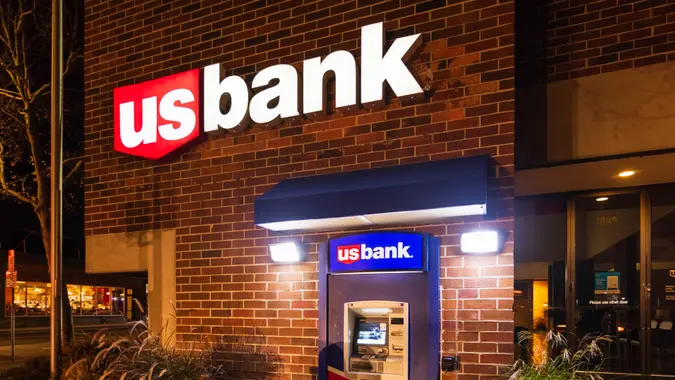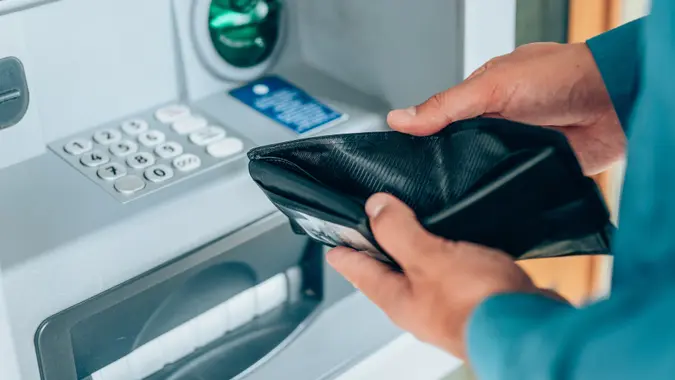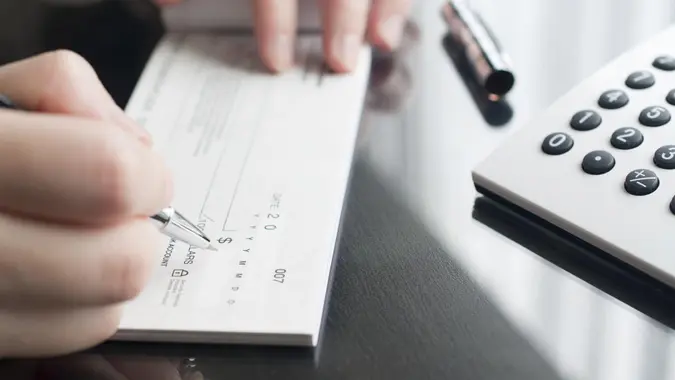What Is a Certified Check and How Do You Get One?

Commitment to Our Readers
GOBankingRates' editorial team is committed to bringing you unbiased reviews and information. We use data-driven methodologies to evaluate financial products and services - our reviews and ratings are not influenced by advertisers. You can read more about our editorial guidelines and our products and services review methodology.

20 Years
Helping You Live Richer

Reviewed
by Experts

Trusted by
Millions of Readers
If you want to make a large purchase, such as buying a car or putting a down payment on a new home, you might be wondering about the best payment method to use. Carrying large sums of cash can be impractical and risky. Some sellers don’t accept personal checks as payment because they can’t be sure the check will clear. Fortunately, certified checks are convenient, secure and as good as cash.
Read on to learn everything you need to know about getting and using certified checks.
How a Certified Check Works
A certified check is a type of personal check that a bank guarantees by setting aside money in your bank account. By certifying the check, the bank verifies that the account it’s written from has enough money to cover the cost of the check and prevents that money from being used for any other purpose. Essentially, though it is drawn from personal funds, a certified check is one guaranteed by the bank.
Before issuing a certified check, the bank verifies that the funds are available and reserves them until the check is cashed. These checks usually don’t expire.
What Is the Bank’s Role?
When issuing a certified check, the bank confirms that the payer has the necessary amount of funds in their checking account to cover the check amount. The bank also places a hold on the funds associated with the check. The certification gives recipients more confidence that the check will clear.
Step-by-Step Process
Here’s how a certified check works:
- Request certification: The customer requests certification for a check.
- Bank confirmation: The bank confirms that the customer has enough funds in the account to cover the check.
- Bank hold” The bank places a hold on the check amount and marks the check as “certified.”
When To Use a Certified Check
A certified check might be useful in the following situations:
- Real estate purchases
- Down payments on home purchases
- High-value private transactions, like buying a car or a collectible
The main benefit of using a certified check includes payment security for the recipient. With the bank’s stamp of approval, the recipient can have more confidence in the fact that the check will clear and they will avoid becoming fraud victims.
Certified Check Pros and Cons
| Pros | Cons |
|---|---|
| Safer than carrying cash or personal checks | Often come with fees |
| Funds guaranteed by the bank | Susceptible to checking scams |
| Widely accepted by many businesses | Not issued by all banks |
Costs and Limitations
Each bank sets its own fees for certified checks. Some banks include complimentary official checks as a perk for certain accounts. Others may charge as much as about $15. Call your financial institution to find out what it charges for this service.
Certified checks are paid out of your own bank account, so make sure you have enough to cover the check’s amount. If not, make a deposit or transfer over funds before writing the check. You won’t have access to this money after the bank certifies the check.
Certified Check vs. Other Payment Methods
A certified check isn’t the only payment option out there. Here’s how it stacks up against the alternatives.
Certified Check vs. Cashier’s Check
A certified check is drawn from your account. In contrast, a cashier’s check is drawn from the bank’s funds.
| Feature | Certified Check | Cashier’s Check |
|---|---|---|
| Funding Source | Paid directly out of the customer’s bank account, using funds that have been set aside by the bank | Paid by the bank using funds withdrawn from the customer’s account |
| Cost | Varies by bank, may be up to about $15 | Varies by bank, often between $5 and $20 |
| How To Order | Through your bank, usually in person; not available from all banks and credit unions | Through your bank, usually in person; sometimes available online or by phone |
Certified Check vs. Personal Check
A personal check doesn’t come with any of the guarantees that a certified check comes with.
| Feature | Certified Check | Personal Check |
|---|---|---|
| Funding source | Paid directly out of the customer’s bank account, using funds that have been set aside by the bank | Paid directly out of the customer’s bank account |
| Cost | Varies by bank, may be up to about $15 | Free if you already have a checkbook |
| How To Order | Through your bank, usually in person; not available from all banks and credit unions | Write a check from your checkbook |
Certified Check vs. Electronic Transfers
An electronic transfer is typically faster than a certified check. While an electronic transfer is generally secure, these might not always be feasible or accepted for certain transactions.
| Feature | Certified Check | Electronic Transfers |
|---|---|---|
| Funding source | Paid directly out of the customer’s bank account, using funds that have been set aside by the bank | Funds are transferred electronically from one account to another |
| Cost | Varies by bank, may be up to about $15 | Fees vary — often free but can cost up to $30 or more |
| How To Order | Through your bank, usually in person; not available from all banks and credit unions | Initiated online, through a mobile app or at a branch |
How To Get a Certified Check
You can purchase a certified check from your bank or credit union. Not all banks offer certified checks, so call ahead to make sure it’s an option. Here’s what to do if your bank offers certified checks:
- Prepare the cash needed to fund the check. Make sure you have enough money in your checking account to cover the amount of the check plus funds to pay any additional fees.
- Collect the information needed for the check. Your bank can give you specific instructions for getting a certified check. You’ll typically need:
- Your account number
- The recipient’s name
- Funds to cover the amount of the check and the fee
- A form of ID, such as a driver’s license or passport
- Write the check. The bank may require you to write a personal check in front of a teller before certifying it.
- Present the check to a teller. The teller will then verify the funds and mark the check as certified.
- Keep the receipt for your records. Retain it until the check clears your account. If the check is lost or stolen, the receipt serves as a record of the transaction.
Alternatives To Certified Checks
Certified checks aren’t the only option. Here’s a look at some alternatives:
- Money order: Money orders are widely available and ideal for lower value transactions.
- Personal check: If you already have a checkbook and the vendor accepts personal checks, this can be the most cost-effective option.
- Cashier’s check: Cashier’s checks are ideal for high-value transactions due to the bank’s guarantee.
- Electronic payments: If you want an immediate transaction sent to a trusted recipient, electronic payments are ideal.
Conclusion
A certified check is a useful and safe payment method because the funds are guaranteed by the issuing bank. Many banks charge a fee to issue certified checks, which can be up to about $15 per check. However, not all banks offer them.
Take a closer look at the fine print and fees before moving forward with a certified check.
FAQ
Here are the answers to some commonly asked questions about certified checks.- Are certified checks refundable if unused?
- Generally, certified checks aren't refundable. If a certified check remains unused, it's possible you can head to the bank for a refund. But the refund availability varies based on the bank.
- What’s the maximum amount for a certified check?
- The maximum amount for a certified check varies from bank to bank. But you won't be able to get a certified check for more than the amount in your bank account.
- Can a certified check be canceled?
- In cases of theft or fraud, a certified check might be canceled. But, generally, certified checks cannot be canceled.
- How long does it take to get a certified check?
- It often takes one or two business days to receive a certified check. But the exact timeline varies based on your financial institution.
- What should I do if a certified check is lost or stolen?
- Contact your bank immediately if a certified check is lost or stolen. The bank representatives can help you through the next steps.
Nicole Valentine, Caitlyn Moorhead and Cynthia Measom contributed to the reporting of this article.
Our in-house research team and on-site financial experts work together to create content that’s accurate, impartial, and up to date. We fact-check every single statistic, quote and fact using trusted primary resources to make sure the information we provide is correct. You can learn more about GOBankingRates’ processes and standards in our editorial policy.
- Capital One. 2023. "Do checks expire? Here’s what you need to know."
- United States Senate Federal Credit Union. 2022. "Cashier's Check Fraud & Scams."
 Written by
Written by  Edited by
Edited by 
























